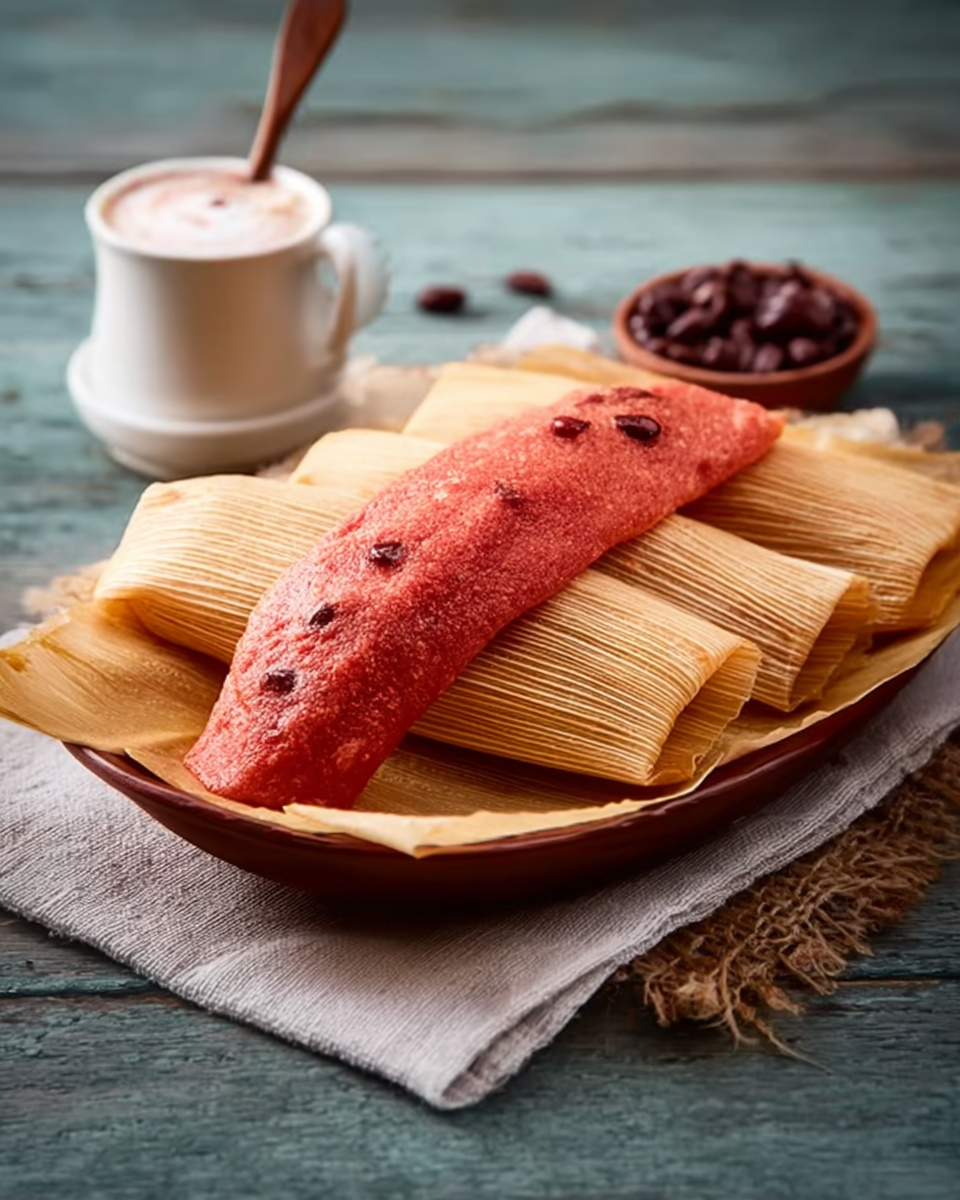The traditional Mexican sweet tamal, or tamal dulce, is a beloved staple across generations and celebrations. Fluffy, vibrant pink masa surrounds pockets of sweet raisins, creating a comforting blend of texture and flavor. This dish brings a splash of color and joy to the breakfast table or any festive occasion.
Perfectly paired with hot atole or a rich Mexican hot chocolate, these tamales are not only visually stunning but also a nostalgic journey into the warmth of home kitchens. Whether you’re celebrating a holiday or just craving something heartwarming, these sweet tamales are a cherished classic that never goes out of style.
Full recipe:
Ingredients:
-
250 grams lard
-
3 cups masa harina (corn flour for tamales)
-
1 tablespoon baking powder
-
1 can (12 oz) CARNATION® CLAVEL® Evaporated Milk
-
1 cup water
-
1 can (14 oz) LA LECHERA® Sweetened Condensed Milk
-
Red food coloring (to achieve signature pink color)
-
14 corn husks (soaked in hot water until pliable)
-
1 cup raisins
Directions:
-
In a large mixing bowl, beat the lard until creamy and fluffy. Gradually add the masa harina and baking powder.
-
Slowly mix in the evaporated milk, water, and sweetened condensed milk. Continue to beat the mixture for about 10 minutes until smooth and fully combined.
-
Add a few drops of red food coloring and stir until the batter turns the traditional pink color of sweet tamales.
-
Spread a portion of the batter onto a softened corn husk. Add a few raisins to the center and carefully fold the tamal, making sure the filling is enclosed. Repeat with remaining batter.
-
Arrange the tamales upright in a steamer pot. Steam using the double boiler method for 1.5 hours, or 30–35 minutes in a pressure cooker from the moment it begins to whistle.
-
Let the tamales rest for 10 minutes before serving warm.
Prep Time: 20 minutes | Cooking Time: 90 minutes | Total Time: 1 hour 50 minutes
Kcal: 412 kcal | Servings: 14 tamales
Cultural Significance and Festive Joy
Tamales in all forms carry immense cultural weight in Mexico and throughout Latin America. They are not just food—they are rituals. Preparing tamales is often a communal effort, known as a tamalada, where families and friends gather in the kitchen to assemble dozens (or even hundreds) of tamales for a special occasion. Each person has a role, whether it’s spreading masa onto corn husks, placing the filling, folding, or steaming. Sweet tamales, in particular, evoke a sense of nostalgia and homecoming. They’re commonly served during holidays like Christmas, New Year’s, and the Feast of the Candelaria, where they are shared among guests as a symbol of community and abundance.
In many homes, especially those influenced by generational family recipes, these tamales are part of childhood memories and stories told around the breakfast table. The aroma of masa, milk, and raisins steaming in a pot fills the air with comfort. Children often wait eagerly to unwrap the soft corn husk and bite into the warm, fluffy interior. These tamales become a taste of heritage, a bite that brings generations together.
The Role of Dairy in Texture and Taste
A key characteristic that sets sweet tamales apart is their use of dairy products, specifically evaporated milk and sweetened condensed milk. These two ingredients contribute both richness and sweetness to the masa. Evaporated milk enhances the creamy consistency of the dough, making it less dry and more velvety. Sweetened condensed milk, on the other hand, brings the sweetness that defines the dish without requiring additional sugar.
The lard used in the dough also plays a significant role in the final texture. It ensures that the masa is light and airy once steamed. When beaten thoroughly—an essential step in traditional tamal preparation—the lard helps create a batter that traps steam effectively, allowing the tamales to puff up while cooking. Combined with dairy and the slightly chewy texture of raisins, this results in a delightful bite that’s both fluffy and moist.
Visual Appeal with a Signature Pink Hue
Perhaps one of the most striking features of sweet tamales is their pink color. Achieved by adding just a few drops of red food coloring to the masa mixture, this visual detail is not merely aesthetic but deeply rooted in tradition. The pink hue serves as a quick identifier, especially in households where multiple tamale varieties are prepared. It says “this one is sweet” before you even open the husk.
This festive appearance makes sweet tamales especially popular during holidays. On a tray of assorted tamales, the pink ones stand out—inviting children and adults alike to indulge in something a little special. In some versions of the recipe, colorful sprinkles or bits of candied fruit are added for an extra visual and textural flourish, making the dish even more fun and inviting.
Versatility Across Meals and Occasions
While traditionally enjoyed during breakfast, sweet tamales are incredibly versatile. In many homes, they double as desserts or afternoon snacks. They pair beautifully with warm beverages like atole (a thick, spiced corn-based drink), champurrado, or Mexican hot chocolate. This makes them ideal for chilly mornings, cozy evenings, or festive family gatherings.
Because they’re individually wrapped in corn husks, they’re also perfect for sharing or gifting. Many people bring tamales to church, school, or work events, where they can be reheated and served with minimal fuss. Their portability and shelf-life (when stored properly) add to their practicality as a traditional yet adaptable dish.
Health and Nutrition Profile
Although tamales are often seen as indulgent, sweet tamales offer a balance of nutrition and comfort. Each tamal contains approximately 412 calories and delivers over 6 grams of protein, thanks to the inclusion of corn flour and dairy. The dish also includes 52.9 grams of carbohydrates and 3.2 grams of dietary fiber per serving, offering some level of satiety. The 20 grams of fat (with 7.9 grams being saturated) do contribute to the richness, but also provide energy, especially useful when tamales are consumed as part of a hearty breakfast.
Like many traditional foods, moderation is key. When enjoyed occasionally and in mindful portions, sweet tamales can be a satisfying part of a balanced diet. Their richness means you’re likely to feel full with just one or two, making them a satisfying and comforting dish without the need to overindulge.
Tips for Preparation and Serving
Making tamales is a labor of love, and a few key tips can help ensure they turn out beautifully every time. First, be sure to soak the corn husks in hot water until they become pliable. This makes them easier to fold and wrap without tearing.
Second, beating the lard thoroughly is crucial to achieving the airy texture of the dough. Traditional cooks often test the dough’s readiness by dropping a small amount in water—if it floats, it’s ready to be steamed.
Third, steaming tamales takes time and patience. If using a regular pot, steam them over a rack placed inside with enough water to last the full cooking time (around 90 minutes). Alternatively, a pressure cooker can be used to reduce cooking time to about 30–35 minutes from the moment it begins to whistle.
When serving, you can offer them as-is, or pair them with hot beverages for a traditional experience. Garnishing with a light dusting of cinnamon or a drizzle of condensed milk can also elevate the dish, especially when serving to guests or during holidays.
A Dish Rooted in Family and Memory
Sweet tamales are more than just food—they’re storytelling wrapped in corn husks. For many, they evoke memories of early mornings with family, the sound of laughter in a busy kitchen, or the aroma of steaming pots during festive nights. In every bite, there’s a sense of belonging, of being part of something timeless and deeply meaningful.
Each element—the creamy dairy, the touch of food coloring, the chewy raisins—plays a role in that experience. Whether it’s a grandmother’s cherished recipe or a modern twist on the classic, the essence of sweet tamales lies in connection. Connection to culture, to family, and to the joy of preparing and sharing something made with care.
Conclusion
The tradition of sweet tamales continues to thrive because it blends flavor, history, and community in one delicious package. Their distinctive pink color, creamy texture, and sweet flavor set them apart from other tamales and offer a wonderful way to celebrate both everyday life and special occasions.
Whether enjoyed during holidays or made simply to bring comfort to a weekend breakfast, sweet tamales offer an experience that’s as heartwarming as it is delicious. Rooted in cultural heritage and made for sharing, they remain a beloved part of Mexican cuisine—and a testament to the beauty of tradition carried forward, one steamed corn husk at a time.






